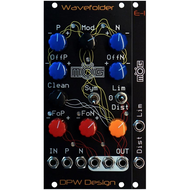WF-1 Wavefolder + E-1 Expander - DPW Design
by Jason Czyeryk
When we interviewed Dan Wahlbeck of DPW designs back in issue #8, he mentioned that after he released his Wavefolder module, WF-1, he didn’t do any designing for six months afterwards because he was having so much fun with the WF-1. I figured there was a bit of hyperbole in that statement, but still it was a comment that stuck with me. I mean, wavefolders are fun, but six months? I dunno. It piqued my curiosity enough for me to grab one when I had the chance, aware that I couldn’t get swept away for six months as I had other duties to attend to, but to see if the temptation to do so was there.
WF-1 has a nice, colorful, and somewhat playful design. There is a black faceplate with squiggly lines, both an attractive and informative visual that indicates signal flow. The white lines denote the clean signal, the yellow lines signify the modulation path, and the red lines are the output. Coupled with the multi-colored knobs on the module, and a sturdy build, there is something very alluring about WF-1 right away.
The module has two sides to it, a positive [P] side and a negative side [N]. The P folds the positive side of the signal, and the N the negative. Both sides have a CV input with attenuverting control and bi-color green and red LEDs—which indicate the level and polarity of the signal—a 12ishV peak-to-peak positive/negative offset control, which sets the threshold where the folding starts, and at the bottom of the module—signified by the red knobs and labeled FoP and FoN—are output attenuverters for adding or subtracting a square-ish wave to the main output, also indicated with bi-color LEDs.
There is a mono input, inputs for both positive and negative CV control, a CLEAN input level control, and a MODulation amount level control. There is also a main OUT level control and three outputs: a main OUT, and two pulse wave outputs; one each for the positive and negative outputs that put out pulse waves when their respective wavefolders are folding, and are indicated by bi-color LEDs. If a pulse wave output is patched, that respective wave [FoP, FoN] is removed from the main OUT and those attenuverters determine the size/shape/polarity/strength of the outputted pulse wave.
There are two toggles; a SYM switch to choose either symmetrical or asymmetrical folding of the signal, and a LIM/0/DIST switch for adding either a soft-stepped limiter [LIM]—which can be driven by the CLEAN volume control—or a frequency dependent distortion and both the LIM and DIST can work with audio or control signals.
Wavefolders are really fun to experiment with, especially when hooked up to an oscilloscope, and WF-1 is no different. Messing around with a simple wave and just the positive side of WF-1 and patching the three outputs, as well as an undiluted input before going through the WF-1, and into my Mordax DATA, and you can see all of the interesting interplay that can happen between all of the available parameters. You mostly get a variation of a waveform that looks like Batman’s head, but adding some of the FoP in the mix to this added more harmonics, and of course patching into the negative CV brought about more radical changes. Messing around with the SYM and adding LIM or DIST was a good way to add a some subtle distortion, while still using a sequenced sine wave and using the E-1 expander—included with the module—adds CV ability for the LIM/DIST toggle. For this to work the toggle needs to be in the center position, with each being CV’ed independently. It would have been nice to not need the expander for this function as the expander is mostly empty space, but it opens up more functionality, especially in terms of accenting something in the time domain, whether rhythmically or melodically, and whether you’re controlling an audio wave or modulation. A quick look at the underside of the WF-1 and you can understand the need for an expander: DPW uses durable, great feeling full-size pots and there is no more space for anything else under the faceplate.
Patching in more complex waveforms and WF-1 becomes a veritable funhouse mirror with much more zany and way less predictable waveforms at the main OUT. You do need to pay attention as it’s possible that incoming modulation and the settings on WF-1 cancels itself out to where you’re flatlining—dead—and it might require some math or sidekick detective skills, but that’s actually part of the fun, this semi-educational aspect to WF-1. On the flipside you could just skip learnin’ and stuff and just twist knobs and sh#t. That also works.
Using the Bastl Pizza as my oscillator and cross-patching between it and WF-1, patching the pulse outputs of the WF-1 into various CV ins on the Pizza, yielded some pretty bizarre results. From pulse-widthy tones to bitcrushing, to metallic swashbuckles, I was able to get a lot of variety. Having said that, I think I enjoyed WF-1 even more as a modulation source, to control the gain on a VCA or a filter cutoff, using WF-1 to output random envelopes for those duties. Controlling the FM Index on Pizza while at the same time using the positive pulse output of WF-1 to modulate the octave of Pizza, gave up some froggy formant basslines that were cool.
This is a really unique wavefolder. I was able to pull myself away from WF-1 so that I didn’t spend six months entranced by it and was able to get other things done, but it wasn’t as easy as you’d think.
12 HP +12v 140mA -12v 140mA
Price: $174 [expander included]
EP-1 Expander 2 HP, passive


